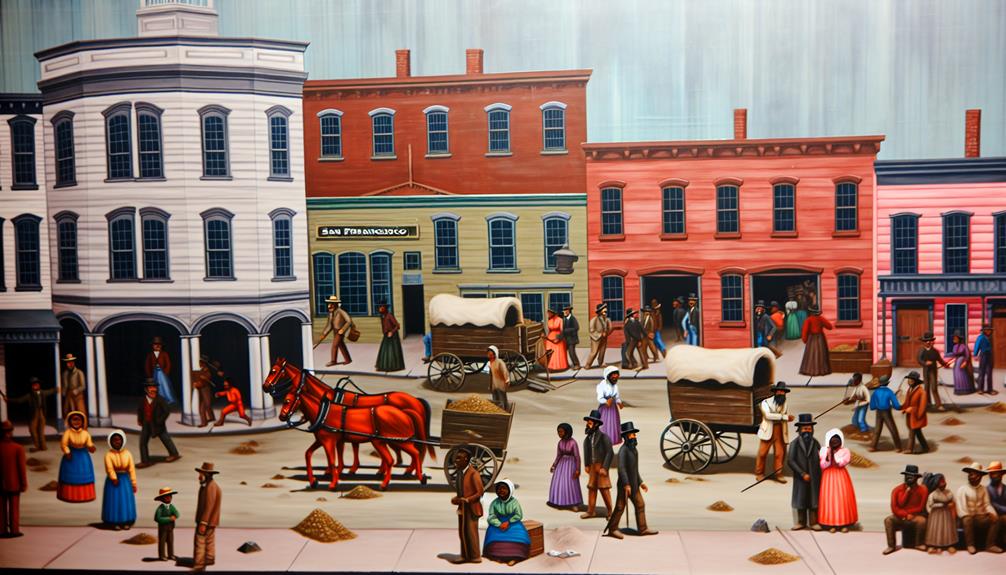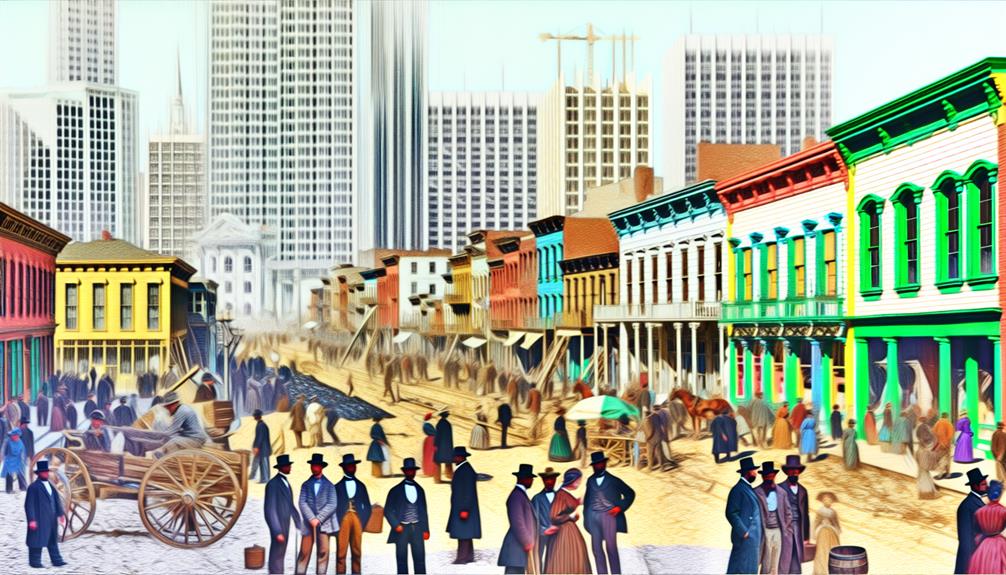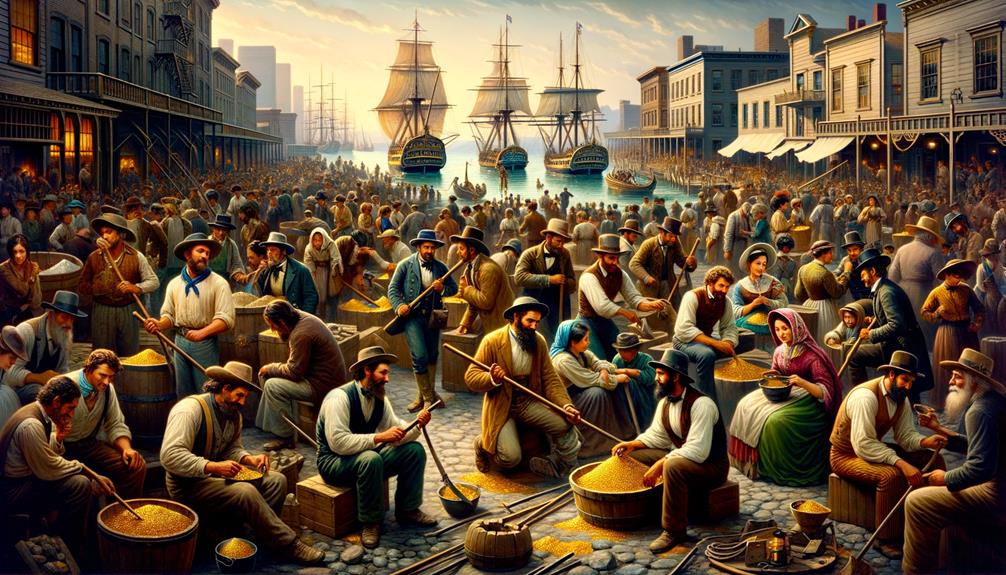The Gold Rush of 1849 had an immense impact on San Francisco’s past, reshaping the city in ways unimaginable. As you stroll through the streets of modern-day San Francisco, remnants of this transformative era linger, hinting at a history filled with rapid change and opportunity. From the sudden influx of fortune-seekers to the lasting cultural influences, the Gold Rush’s effects on Francisco’s past are profound and multifaceted.
But what exactly were these changes, and how did they shape the city we know today?
Table of Contents
ToggleKey Takeaways
- Economic boom transformed San Francisco into a commerce and trade hub.
- Rich cultural exchange formed a diverse melting pot.
- Infrastructure changes laid the foundation for continued growth.
- Social dynamics fostered tolerance and cooperation among diverse communities.
1849 Gold Rush Impact on San Francisco

The Gold Rush had a profound and lasting impact on the city of San Francisco, shaping its economy, demographics, and cultural landscape in significant ways. The environmental impact and changes to the natural landscape were striking. The influx of people searching for gold led to extensive deforestation, soil erosion, and pollution of waterways due to mining activities. This altered the region’s ecosystems irreversibly, affecting wildlife and vegetation.
Labor relations and working conditions also underwent dramatic shifts during the Gold Rush. The demand for labor in mines and support industries resulted in harsh working conditions for miners, with long hours, low wages, and dangerous environments. Miners often faced exploitation and discrimination, leading to labor unrest and strikes. These challenging conditions laid the groundwork for future labor movements and the development of workers’ rights in San Francisco.
Population Boom and Urban Development
Amidst the chaos and rapid changes brought about by the Gold Rush, San Francisco experienced an unprecedented influx of people, triggering a population boom and spurring urban development. The sudden surge in population led to a severe housing crisis, with demand far outstripping the available accommodations. Makeshift structures and shantytowns sprang up in response to the housing shortage, creating congested and unsanitary living conditions for many newcomers.
Transportation challenges also emerged as the city struggled to accommodate the growing population. The existing infrastructure was ill-equipped to handle the influx of people, leading to overcrowded streets and limited public transportation options. The need for efficient transportation became increasingly urgent as the city expanded rapidly to accommodate its new residents.
The population boom and urban development during this period laid the groundwork for the transformation of San Francisco into a bustling metropolis. Despite the challenges faced, the city’s ability to adapt and evolve in the face of such rapid change showcases the resilience and dynamism that would come to define San Francisco in the years to come.
Economic Growth and Infrastructure Changes

As San Francisco’s population surged and urban development accelerated during the Gold Rush, significant economic growth and infrastructure changes began to reshape the city’s landscape. The influx of miners, entrepreneurs, and settlers fueled an economic boom that transformed San Francisco into a bustling hub of commerce and trade. With the discovery of gold, the city experienced an industrial revolution of sorts, as new industries sprang up to support the growing population and meet their needs.
Technological advancements played a crucial role in this period of rapid development. Innovations such as steam-powered machinery, transportation networks, and communication systems revolutionized the way business was conducted in the city. The construction of roads, bridges, and buildings transformed the physical infrastructure of San Francisco, laying the foundation for its future growth and prosperity.
The economic growth and infrastructure changes brought about by the Gold Rush not only shaped the city’s landscape but also set the stage for its continued expansion and development in the years to come.
Cultural Diversification and Social Dynamics
During the Gold Rush era, San Francisco underwent a profound transformation in cultural diversification and social dynamics as the city welcomed a diverse influx of individuals seeking fortune and opportunity. This period marked a significant shift in the city’s demographics and societal structure. Below are three key aspects that highlight the impact of cultural exchange and social integration during this transformative era:
- Cultural Exchange: The Gold Rush brought people from all corners of the globe to San Francisco, leading to a rich tapestry of cultural exchange. Different languages, traditions, and customs merged, creating a vibrant multicultural environment that shaped the city’s identity.
- Social Integration: Despite initial challenges and tensions due to the diverse backgrounds of the inhabitants, San Francisco gradually evolved into a melting pot where people from various ethnicities and social classes coexisted. This process of social integration fostered understanding, tolerance, and cooperation among the different communities.
- Formation of Communities: As individuals from different backgrounds settled in San Francisco, they formed distinct communities based on shared cultural heritage or common goals. These communities played a crucial role in supporting their members, preserving traditions, and contributing to the city’s diverse social fabric.
Legacy of Gold Rush in San Francisco

The enduring legacy of the Gold Rush in San Francisco is evident in the city’s modern-day cultural landscape and economic vitality. It showcases how the historical influx of diverse individuals continues to shape the city’s identity and prosperity.
The Gold Rush brought together people from all walks of life, leading to a cultural transformation that laid the foundation for San Francisco’s reputation as a melting pot of different backgrounds and perspectives. This rich tapestry of diversity is still celebrated today in various cultural events, neighborhoods, and institutions throughout the city.
Moreover, the historical significance of the Gold Rush in San Francisco can be seen in the city’s economic prosperity. The rapid growth and development spurred by the Gold Rush set the stage for San Francisco to become a major financial and technological hub. The entrepreneurial spirit that characterized the Gold Rush era continues to drive innovation and economic growth in the city, making it a global powerhouse in various industries.





